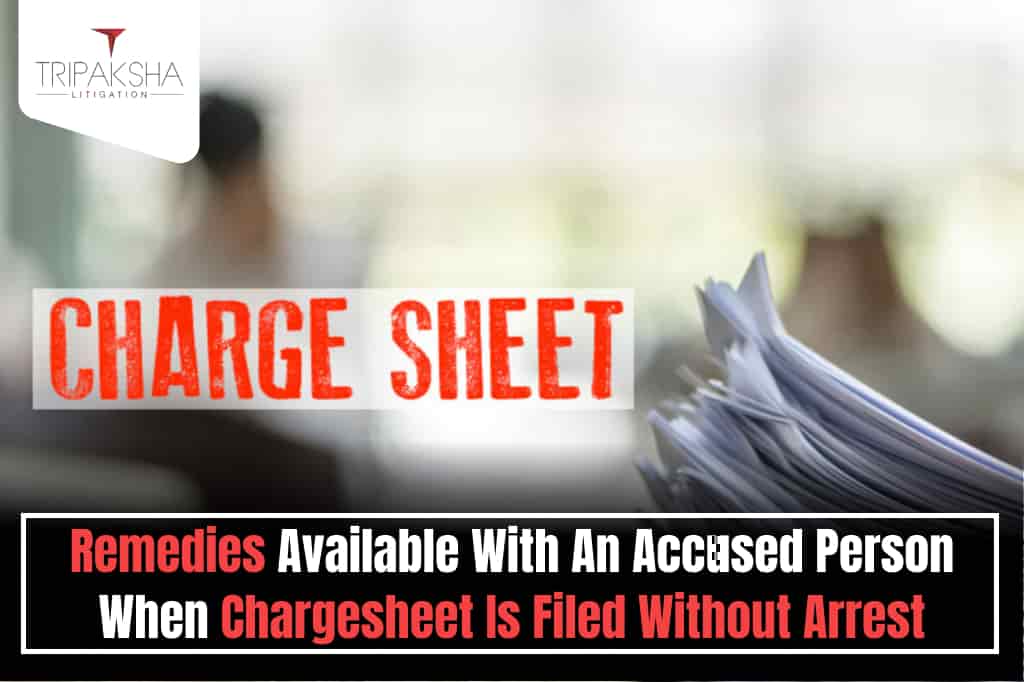When a charge sheet is submitted without an arrest in a cognizable case, there are several measures exist to protect the liberty of an individual who fears being detained by the court during their first appearance. This article will help one in exploring the remedies provided under sections 205, anticipatory bail, section 88, and regular bails.
I. Introduction
Protecting the individual liberty is essential, but it can be compromised when someone is accused of a crime and deemed by the investigating agency or court to be held in custody. Striking a balance between liberty and the necessity for custody is crucial. Sometimes, despite evidence suggesting guilt, the investigating agency may choose not to arrest an individual, especially if they have cooperated fully and are expected to attend trial.
When the agency submits a charge sheet to the court without arresting the individual, confusion arises. The court then issues a summons or warrant, requiring the individual’s presence. This prompts concerns about potential custody, leading individuals to seek legal remedies to safeguard their liberty.
II. Background and the Issue’s Origin
Typically, reactive behaviours like fleeing, tampering with evidence, or attempting to influence witnesses occur during investigations, not after. Therefore, one might assume that if the investigating agency hasn’t deemed arrest necessary, neither should the court.
Confusion often stems from misinterpretations of section 170 of the Code of Criminal Procedure, 1973 (CrPC). This section implies that if the agency finds sufficient evidence against an individual, they must forward that individual to the court with or without custody. This has led to misconceptions such as:
- The individual must be taken into custody.
- The charge sheet cannot be filed without custody.
- The individual will be taken into custody upon their first court appearance if absent.
However, the true essence of the law aims to ensure the court records all evidence in the accused’s presence. This principle is also reflected in other CrPC sections, such as section 273, which mandates the accused’s presence during evidence-taking.
A significant Supreme Court decision, Siddharth v State of UP (2022) 1 SCC 676, clarified that ‘custody’ in section 170 CrPC simply means presenting the accused in court, not necessarily arresting them.
III. Available Remedies with the person when chargesheet is filed without arrest
(a) Section 438 of CrPC – Anticipatory Bail
Apply for anticipatory bail under Section 438 of the Code of Criminal Procedure (CrPC) to prevent potential arrest. The Supreme Court’s decision in Bharat Chaudhry v State of Bihar (2003) 8 SCC 77 affirmed that filing a charge sheet or taking cognizance doesn’t hinder anticipatory bail. Recent decisions like Siddharth v State of UP (2022) 1 SCC 676 further reinforce this stance.
In the landmark Gurbaksh Singh Sibbia case, the Constitution Bench clarified that anticipatory bail can be granted as long as the applicant hasn’t been arrested. The Bench didn’t rule out the possibility of seeking anticipatory bail after the charge sheet has been filed, stating that such an application can be made once the investigation is complete. The court can set conditions when granting pre-arrest bail, including limiting the bail’s duration if the situation warrants it. This decision highlights that the stage at which the anticipatory bail application is made—whether before the FIR is lodged, during the investigation, or after the charge sheet is filed—can influence the court’s decision on imposing conditions.
(b) FIR Quashing
If the First Information Report (FIR) is baseless or malicious, . It involves filing a petition under Section 482 of the CrPC to the High Court to quash it dismiss the FIR and any associated legal proceedings against the accused.
The Code of Criminal Procedure, 1973, outlines the inherent powers of the High Court in Section 482 [1] as follows:
- Section 482 states that the High Court possesses the authority to take any action necessary to ensure that justice is served properly.
- Under this provision, the High Court can dismiss an FIR if it believes that the FIR is false and has been filed with the intent to harm or harass the complainant.
- If an individual is accused of a non-compoundable offence, they have the option to approach the High Court and submit a Writ Petition under Article 226 of the Indian Constitution in conjunction with Section 482 of the CrPC.
- The onus is on the petitioner to demonstrate that the FIR was lodged with malicious intent solely to trouble or harm them.
Reasons for Quashing an FIR
The Supreme Court of India, in cases like Sundar Babu & Ors vs. State of Tamil Nadu and State of Haryana vs Bhajan Lal, has provided essential guidelines on the circumstances and criteria for quashing an FIR under Section 482 of the CrPC. Here are the key grounds:
- If the allegations in the FIR or complaint, even when accepted at face value, do not establish any offence or present a case against the accused.
- When the allegations in the FIR or complaint are so unreasonable and improbable that no reasonable person could conclude there’s a valid basis for proceeding against the accused.
- If the FIR and accompanying materials do not indicate a cognizable offence that would justify a police investigation under Section 156(1) of the CrPC without a Magistrate’s order as per Section 155(2).
- If the allegations in the FIR only pertain to a non-cognizable offence, meaning a police officer can’t investigate without a Magistrate’s order under Section 155(2).
- When the allegations in the FIR, along with supporting evidence, fail to demonstrate that an offence has been committed or establish a case against the accused.
- If there’s a specific legal provision in the CrPC or the relevant Act that prevents the initiation or continuation of the proceedings, or if there’s a provision offering an effective remedy for the complainant.
- When the criminal proceedings are clearly driven by malicious intent or ulterior motives, such as seeking revenge against the accused or settling a personal vendetta.
The High Court’s use of its powers under Section 482 of the CrPC to quash cases is largely based on the judge’s personal judgment. The judge must carefully weigh the court’s authority under Section 482 against the specific circumstances of the case. Consequently, there are no fixed criteria set for the High Court’s exercise of these powers.
While Section 320 of the Code of Criminal Procedure requires that certain criminal cases can be settled or “compounded” by the subordinate courts either during trial or on appeal, Section 482 of the CrPC takes precedence over this provision. This is due to the broad discretionary powers granted to the High Court for quashing FIRs.
(c) Section 88 of CrPC – Furnishing Bond
Section 88 allows the court to require an accused to execute a bond for their appearance. Recent decisions, like Satender Kumar Antil v CBI 2022 SCC OnLine SC 825, clarify that there’s no need for arrest when an accused is forwarded to the court under section 170.
(d) Regular Bail (Section 436 CrPC)
As a last resort, the accused can appear in court and seek regular bail. Depending on the court’s decision, the accused may be granted immediate bail, interim bail, or denied bail. Apply for bail after appearing in court. Bail decisions consider factors like offence severity and flight risk.
(e) Section 205 of CrPC – Exemption from Personal Appearance
Under section 205, an accused can request exemption from personal court attendance and appear through their lawyer. The court grants this based on valid reasons, like the accused holding a significant position or being a daily wage earner. The essence is to ensure a fair trial, preventing proceedings or evidence from happening behind the accused’s back.
(f) Defend the Charges
In a trial scenario, the accused can present their defence, provide evidence, call witnesses, and cross-examine the prosecution’s witnesses.
-In case if Complainant is not satisfied with the content of chargesheet.
(a) Challenge the Chargesheet through Protest Petition
If there are grounds to challenge the chargesheet, such as insufficient evidence or procedural lapses, the accused can file a Protest petition to quash it, demonstrating its deficiencies.
Protest Petition is not explicitly defined in the Criminal Procedure Code (CrPC) but holds significant importance in criminal law practice. Here’s how it typically operates:
When an aggrieved individual approaches a Magistrate under section 156(3) of the Cr.Pc with a complaint, the Magistrate, if convinced by the complaint’s merits, directs the police to investigate the matter. Upon completion of the investigation, the police present their report to the Magistrate as per section 173(2) of the CrPC. If the aggrieved person or complainant is dissatisfied with the police report, they can file a Protest Petition before the relevant Magistrate expressing their dissatisfaction. They may request further investigation supervised by the court. Additionally, they can request for proceedings under sections 200 and 202 of the Cr.Pc. If the Magistrate accepts the Protest Petition, they take cognizance of the matter under section 190 of the Cr.Pc and issue a notice to the accused individual. In essence, a Protest Petition serves as a mechanism for complainants to challenge unsatisfactory police reports and seek court-supervised investigations or further proceedings.
IV. Conclusion
The stress surrounding an individual named as an accused but not arrested during the investigation is significant. While remedies are available, their effectiveness varies based on the case’s severity and allegations. Criminal trials demand utmost seriousness, and while these remedies aim to prevent coercive action, they don’t guarantee perpetual protection.








